Invasive Species: Imperata cylindrica, Cogongrass
Cogongrass is an aggressively invasive, colony-forming perennial grass that can grow to 6 ft. (1.8 m) tall. Leaves have off-center, whitish midribs and finely serrated margins. Leaves are up to 6 ft. (1.8 m) long, 0.5 to 0.75 in. (1.3 to 1.9 cm) wide, and stiff and have sharp, pointed apexes. Cogongrass is best identified in the spring by the large, fuzzy panicle of flowers and seeds that gives the plant a cottony or silky look. Flower heads are 2 to 8 in. (5.1 to 20.3 cm) long, silvery white, and cylindrical. The light, fluffy dandelion-like seeds are easily dispersed by the wind and usually don’t remain on the panicle for long. Rhizomes are whitish, branched, scaly, and sharp at the tips. Cogongrass is an extremely aggressive invader capable of invading a range of sites. It forms dense, usually circular infestations that exclude all other vegetation. Cogongrass is shade tolerant, allowing it to invade forested habitats. Cogongrass is native to Southeast Asia and was accidentally introduced in the Southeast United States in packing material in the early 1900s. Also, it was introduced intentionally for erosion control and livestock forage.
What are invasive species, and why should we be concerned about them?
Taxonomy: Scientific and Common Names for This Species
Cyperales > Poaceae > Imperata cylindrica (L.) Beauv.
Synonym(s): cogon grass, alang-alang
Imperata cylindrica – USDA PLANTS Profile
Distribution Maps
cogongrass – The reported distribution of this invasive species across the United States (Source: Invasive Plant Atlas of the United States)
Up-to-the-minute distribution maps and why they are important
Reporting This Invasive Species
What is the best way to report the occurrence of an invasive species?
How to report an invasive species sighting to EDDMapS – Early Detection & Distribution Mapping System
EDDMapS – Report an invasive species to EDDMapS.
County Extension Offices – Find your county Extension office on this map provided by USDA.
How to Identify
This invasive species can be identified by looking for the characteristics described in the paragraphs that follow.
Grass
Cogongrass is an aggressively invasive, colony-forming perennial grass that can grow to 6 ft. (1.8 m) tall.
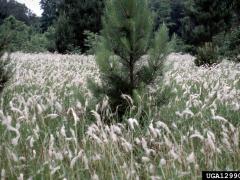 |
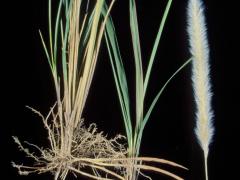 |
| Charles T. Bryson, USDA Agricultural Research Service, bugwood.org | Florida Division of Plant Industry Archive, Florida Department of Agriculture and Consumer Services, bugwood.org |
Foliage
Leaves have off-center, whitish midribs and finely serrated margins. Leaves are up to 6 ft. (1.8 m) long, 0.5 to 0.75 in. (1.3 to 1.9 cm) wide, and stiff and have sharp, pointed apexes.
 |
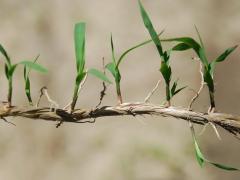 |
| Chris Evans, River to River CWMA, bugwood.org | Nancy Loewenstein, Auburn University, bugwood.org |
Flower
Cogongrass is best identified in the spring by the large, fuzzy panicle of flowers and seeds that gives the plant a cottony or silky look. Flower heads are 2 to 8 in. (5.1 to 20.3 cm) long, silvery white, and cylindrical.
 |
 |
| Chris Evans, River to River CWMA, bugwood.org | Nancy Loewenstein, Auburn University, bugwood.org |
Fruit
The light, fluffy dandelion-like seeds are easily dispersed by the wind and usually don’t remain on the panicle for long. Rhizomes are whitish, branched, scaly, and sharp at the tips.
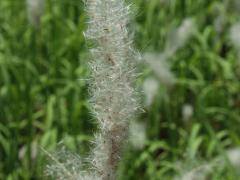 |
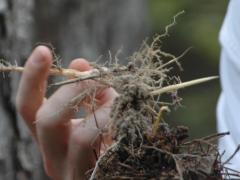 |
| Chris Evans, River to River CWMA, bugwood.org | Karan A. Rawlins, University of Georgia, bugwood.org |
Native Species That Resemble Cogongrass
– Images at invasive.org
| bugwood.org | bugwood.org |
– Images at invasive.org
| bugwood.org | bugwood.org |
Additional Images for Cogongrass
cogongrass – Images at invasive.org
Learning Resources for Cogongrass
Cogongrass – Imperata cylindrica – Georgia Invasive Species Task Force
Identification Field Guide – Cogongrass.org
Additional Information, Biology, Control and Management Resources
Control and management recommendations vary according to individual circumstances. Location, habitat, weather, and a variety of other conditions are factors that help determine the best treatment choice. To find the safest and most effective treatment for your situation, consult your state’s land-grant institution. If you will use chemicals as part of the control process, always refer to the product label.
United States Land Grant University System – Find your Land Grant University’s College of Agriculture, University Cooperative Extension Service, or other related partner on this map provided by USDA.
Invasive Species Management Plans for Florida – University of Florida, Center for Aquatic and Invasive Plants
A Field Guide for the Identification of Invasive Plants in Southern Forests – USDA Forest Service
A Management Guide for Invasive Plants of Southern Forests – USDA Forest Service
Biological Control of Invasive Plants in the Eastern United States – USDA Forest Service
Domestic Programs Pest Evaluation – USDA Animal and Plant Health Inspection Service (APHIS) Plant Protection and Quarantine (PPQ)
Cogongrass Website – Bugwood Network
Identifying and Controlling Cogongrass in Georgia – Georgia Invasive Species Task Force
Weeds Gone Wild: Alien Plant Invaders of Natural Areas – Plant Conservation Alliance
Federal Noxious Weed Disseminules of the United States – USDA APHIS
Weed of the Week – USDA Forest Service
Identification and Biology of Nonnative Plants in Florida’s Natural Areas – University of Florida
